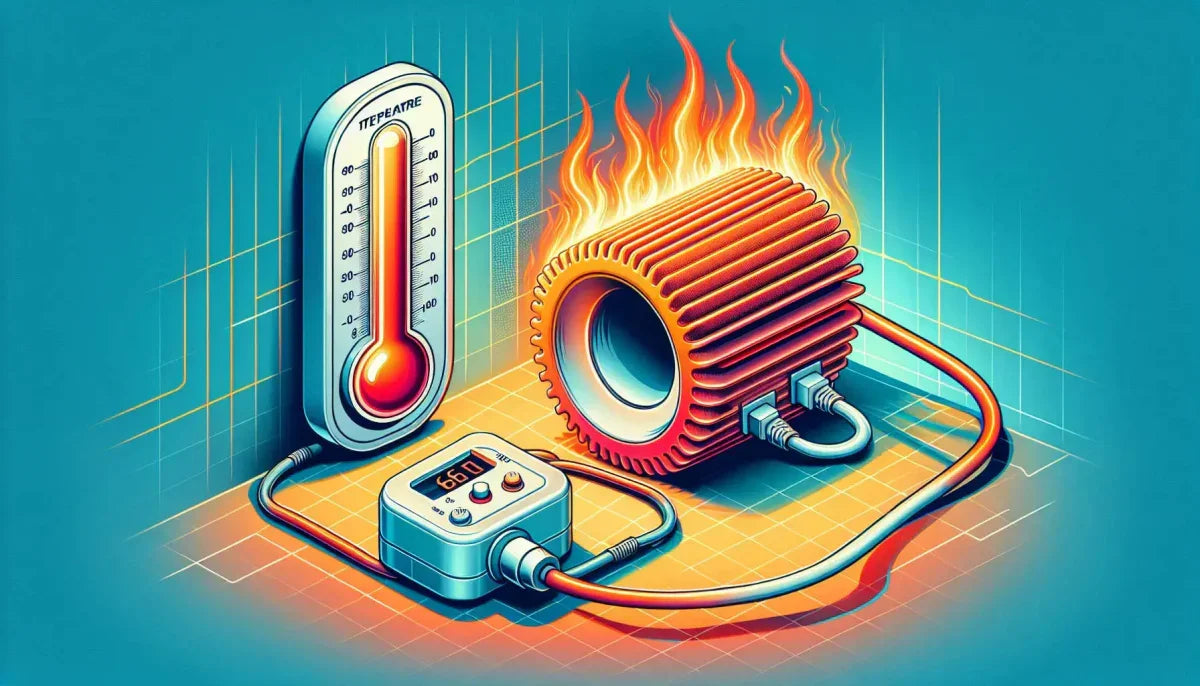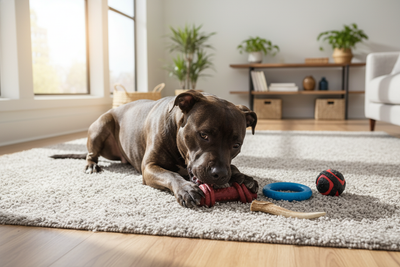
As a reptile owner, understanding the temperature output of a 60 watt ceramic heat emitter is crucial for your pet's health. Ceramic heat emitters provide a reliable and consistent source of heat for reptiles, emitting infrared heat without producing any light. This creates a comfortable environment for your reptile without disrupting their natural day-night cycle.
Maintaining the right temperature is essential for reptiles, as it helps regulate their metabolism, digestion, and overall well-being. Incorrect temperatures can have adverse effects on reptiles, leading to issues such as poor appetite, lethargy, and health complications.
The Role of Ceramic Heat Emitters
Ceramic heat emitters play a crucial role in ensuring the well-being of reptiles. They provide a reliable and consistent source of heat, creating a comfortable environment for your scaly friends.
Some key points to consider:
- Ceramic heat emitters emit infrared heat without producing any light.
- They maintain a consistent temperature, helping to regulate reptile metabolism and digestion.
- Maintaining the right temperature is essential for a reptile's overall well-being.
- Incorrect temperatures can lead to issues such as poor appetite, lethargy, and health complications.
Brands Offering Ceramic Heat Emitters
In the world of reptile care, there are various brands offering ceramic heat emitters. One such brand is Zilla. These emitters are widely available through different retailers, including Chewy and Amazon.
By choosing a reputable brand like Zilla, you can ensure that you are providing the ideal temperature for your scaly friends.
Stay tuned to learn more about providing the ideal temperature for your reptiles.
The Benefits of Ceramic Heat Emitters for Reptile Heating
Ceramic heat emitters are a popular choice for reptile owners when it comes to providing adequate heating for their pets. These devices not only offer efficient and effective heating, but they also prioritize safety. Let's dive deeper into the benefits of using ceramic heat emitters for reptile heating.
Energy Efficiency
One of the key advantages of ceramic heat emitters is their energy efficiency. Unlike traditional heat lamps that emit light as well as heat, ceramic heat emitters solely produce heat, without any light. This means that all the energy consumed is dedicated to heating, resulting in minimal energy wastage. Reptile owners can save on electricity bills while ensuring their pets stay warm and comfortable.
Safe Heating Solution
In addition to being energy efficient, ceramic heat emitters also offer a safe heating solution for reptiles. The absence of light emitted by these devices reduces the risk of disturbing the natural day-night cycle of reptiles. Many reptiles require a period of darkness to regulate their body temperature and maintain their natural behavior. With ceramic heat emitters, reptiles can receive the necessary heat without unnecessary light disruptions.
Moreover, ceramic heat emitters do not emit harmful UVB or UVA rays, which can be detrimental to reptiles if exposed for prolonged periods. This eliminates the risk of reptiles developing health issues such as eye problems or vitamin D deficiency. Reptile owners can have peace of mind knowing that their pets are receiving heat in a safe and controlled manner.
Wattage and Temperature Range
When it comes to selecting the appropriate wattage for a ceramic heat emitter , there are various options available, including the popular 60 watt ceramic heat emitter. However, it's important to note that the specific temperature range of a 60 watt ceramic heat emitter is not mentioned in the provided information. Therefore, it is advisable to consult the product specifications or manufacturer's guidelines to determine the suitable temperature range for your reptile's needs.
Where to Find Ceramic Heat Emitters
To explore a wide range of reptile supplies, including ceramic heat emitters, you can visit websites like Chewy (link: chewy.com/flukers-60w-ceramic-reptile-heat) and Amazon (link: amazon.com/Reptile-Ceramic-Emitter-Infrared-Aquarium). These platforms offer a variety of ceramic heat emitters from different brands, ensuring that you can find the most suitable option for your reptile's heating requirements.
Ceramic heat emitters provide reptile owners with an energy-efficient and safe heating solution. By eliminating light emissions and harmful UV rays, these devices prioritize the well-being of reptiles while effectively maintaining their desired temperature. If you're considering purchasing a ceramic heat emitter, make sure to check the wattage and temperature range that best suits your reptile's needs.
The Role of Power Rating in Ceramic Heat Emitters
The power rating of a ceramic heat emitter is a crucial factor in determining its temperature output. These devices typically have a power rating of 60 watts, which indicates the amount of electrical energy they consume. This energy is then converted into heat by the ceramic element and emitted into the enclosure.
The higher the power rating, the more heat the emitter can produce. However, several other factors also influence the temperature output, such as the size of the enclosure and the level of insulation.
Enclosure Size
The size of the enclosure plays a significant role in determining the power requirement of the heat emitter. A larger enclosure will require a more powerful heat emitter to maintain the desired temperature. On the other hand, a smaller enclosure may not require as much power to achieve the same temperature.
Insulation
The level of insulation in the enclosure is another important factor to consider. A well-insulated enclosure will retain heat more effectively, allowing for better temperature control and reducing the workload on the heat emitter. In contrast, a poorly insulated enclosure may result in heat loss, requiring the heat emitter to work harder to maintain the desired temperature.
It is important to note that the specific temperature range of a 60 watt ceramic heat emitter is not mentioned in the provided information. Reptile owners should always monitor the temperature in their pet's enclosure using a reliable thermometer to ensure that it falls within the appropriate range for their specific reptile species.
The Normal Operating Temperature Range for a 60 Watt Ceramic Heat Emitter
A 60 watt ceramic heat emitter is a popular choice among reptile owners for providing a consistent source of heat in their pet's habitat. But what is the normal operating temperature range for such a heat emitter? Let's dive into this topic and explore the factors that may cause slight variations in temperature.
Factors Affecting Temperature Range
- Ambient room temperature: The temperature of the room where the heat emitter is placed plays a significant role in determining the heat output. If the room is already warm, the heat emitter may not need to work as hard to reach the desired temperature range. Conversely, if the room is cooler, the heat emitter may need to work harder to maintain the desired temperature.
- Distance from the heat source: The proximity of the heat emitter to the reptile's habitat affects the temperature. The closer the heat emitter is, the higher the temperature will be. Conversely, if the heat emitter is placed farther away, the temperature may be slightly lower. It's important to find the right balance and position the heat emitter at a distance that provides the optimal temperature for your reptile.
Monitoring and Species-Specific Requirements
While there is no specific information available about the exact temperature range of a 60 watt ceramic heat emitter, it is essential to monitor the temperature in the reptile's habitat regularly. This can be done using a thermometer specifically designed for reptile enclosures. By keeping an eye on the temperature, you can ensure that it stays within the appropriate range for your pet's species.
It's worth noting that different reptile species have different temperature requirements. For example, tropical reptiles may require higher temperatures, while desert-dwelling species may thrive in slightly lower temperatures. It's essential to research the specific temperature needs of your reptile species to ensure their well-being.
Guidelines for Using a 60 Watt Ceramic Heat Emitter
- Follow manufacturer's instructions: It's crucial to follow the manufacturer's instructions and recommendations when using a 60 watt ceramic heat emitter. This includes using the appropriate wattage for your enclosure size and ensuring proper ventilation to prevent overheating.
- Regularly check for damage: It's important to regularly check the heat emitter for any signs of damage or malfunction to ensure it continues to provide the necessary heat for your reptile.
Proper Temperature Regulation for Reptile Enclosures
When it comes to keeping reptiles as pets, ensuring their safety and well-being is of the utmost importance. One crucial aspect of reptile care is monitoring and regulating the temperature in their enclosure. Reptiles are ectothermic animals, meaning they rely on external heat sources to regulate their body temperature. Therefore, it is essential to provide them with an appropriate temperature range to support their health and overall well-being.
Importance of Temperature Regulation
Maintaining the correct temperature for reptiles is crucial because it directly impacts their metabolism, digestion, immune system, and overall activity levels. If the temperature is too low, reptiles may become sluggish and have difficulty digesting their food. On the other hand, if the temperature is too high, they may become stressed, dehydrated, or even suffer from heatstroke.
Tips for Temperature Regulation
- Invest in a reliable temperature monitor to accurately track the temperature inside the enclosure.
- Ensure proper ventilation to prevent the enclosure from becoming too stuffy or stagnant.
- Select a suitable heat source, such as a ceramic heat emitter, that provides consistent and safe heat without emitting disruptive light.
Recommended Ceramic Heat Emitters
While researching ceramic heat emitters , I came across a popular product on Chewy.com called Fluker's 60W Ceramic Reptile Heat Emitter . This heat emitter is designed to provide a reliable and consistent heat source for reptiles without emitting any harmful light. Please note that the specific temperature range of this heat emitter is not mentioned in the information provided.
In addition to the Chewy.com product, I found another option on Amazon.com - the AIICIOO Reptile Heat Lamp Bulb . This ceramic heat emitter also emits infrared heat and boasts features such as high energy efficiency and durability. However, it is always important to read product descriptions and customer reviews to ensure you are selecting the right heat emitter for your specific reptile species and enclosure size.
Maintaining the proper temperature in a reptile's enclosure is vital for their health and well-being. By investing in a reliable temperature monitor, providing adequate ventilation, and selecting a suitable heat source like a ceramic heat emitter, you can create a comfortable and safe environment for your reptile companion.
Reptile Supplies from Talis-us
As a reminder, Talis-us offers a wide range of reptile supplies, including heat sources and accessories. You can explore their selection of reptile products by visiting their website and checking out their reptile supplies category. Additionally, they offer products from various brands, including Zilla. If you're looking for specific reptile products or accessories, Talis-us is a great resource to consider.
The Advantages of Ceramic Heat Emitters
- Consistent and controlled heat source
- No light emission, ideal for animals that require darkness
- High energy efficiency
- Durable and long-lasting
- Wide temperature range for optimal thermal gradient
Ceramic heat emitters are commonly used heat sources for reptiles and other animals that require specific temperature control. They offer several advantages in terms of temperature control:
Consistent and Controlled Heat Source
One of the main advantages of ceramic heat emitters is their ability to provide a consistent and controlled heat source. Unlike other heat sources, such as heat lamps or heating pads, ceramic heat emitters do not emit light, making them ideal for animals that require darkness for proper sleep. This feature also reduces the risk of disturbing the animal's natural day and night cycle.
High Energy Efficiency
Ceramic heat emitters are highly energy efficient. They convert almost all of the electrical energy they consume into heat, minimizing energy waste. This makes them not only cost-effective but also environmentally friendly.
Durable and Long-lasting
Ceramic heat emitters are constructed from high-quality materials that can withstand high temperatures without breaking or malfunctioning. This ensures that the heat emitted remains consistent and reliable over time, providing a stable environment for the animals.
Wide Temperature Range
Ceramic heat emitters offer a wide temperature range, allowing pet owners to create the optimal thermal gradient within their pets' enclosures. This is crucial for reptiles and other ectothermic animals that rely on external heat sources to regulate their body temperature. By providing a range of temperatures, ceramic heat emitters enable animals to thermoregulate effectively, promoting their overall health and well-being.
Specific examples of ceramic heat emitters include the Fluker's 60W Ceramic Reptile Heat Emitter and the AIICIOO Reptile Heat Lamp Bulb. These products have received positive reviews from reptile owners and enthusiasts, highlighting their effectiveness in maintaining a consistent and controlled heat source. These heat emitters are particularly popular for reptiles such as snakes, lizards, and turtles.
Disadvantages of Ceramic Heat Emitters
- Lack of adjustable temperature settings
- Potential burn risk
While ceramic heat emitters offer many advantages, there are also some disadvantages to consider:
Lack of Adjustable Temperature Settings
Unlike some other heat sources, ceramic heat emitters do not come with built-in temperature control mechanisms. Pet owners need to use external devices, such as thermostats, to regulate the heat emitted by the ceramic heat emitter .
Potential Burn Risk
Ceramic heat emitters can become very hot to the touch during operation, posing a burn risk to animals and humans. It is essential to use appropriate fixtures and enclosures to prevent direct contact with the heat emitter and ensure the safety of both the animals and their caretakers.
Expert Recommendations and Tips
One of the most crucial aspects of reptile care is providing the right temperature for your scaly friend. Reptiles are ectothermic creatures, which means they rely on external heat sources to regulate their body temperature. This is where ceramic heat emitters come in handy. These devices are designed to emit infrared heat, simulating the warmth of the sun and creating a comfortable environment for your reptile.
Expert Recommendations and Tips for Using Ceramic Heat Emitters
- Adjusting the height: The distance between the ceramic heat emitter and your reptile's basking spot can greatly affect the temperature. If your reptile needs a higher temperature, you can lower the emitter closer to the basking spot. Conversely, if a lower temperature is required, raising the emitter higher above the basking spot can help achieve the desired temperature range. This way, you can provide the perfect balance of warmth for your reptile.
- Using a thermostat: Investing in a thermostat is a smart move when it comes to reptile heat management. A thermostat allows you to control and maintain the temperature within a specific range. Simply plug your ceramic heat emitter into the thermostat, set the desired temperature, and let the device do the work for you. This ensures that your reptile's habitat remains consistent and eliminates the risk of overheating or underheating.
Tips for Achieving the Desired Temperature Range with a 60 Watt Ceramic Heat Emitter
- Evaluate the enclosure size: The size of your reptile's enclosure plays a significant role in temperature regulation. Larger enclosures tend to disperse heat more quickly, while smaller enclosures may retain heat. Take into consideration the size of your reptile's habitat when determining the appropriate wattage for a ceramic heat emitter. If you have a larger enclosure, you may need to opt for a higher wattage emitter or use multiple emitters to distribute heat evenly.
- Monitor temperature with a thermometer: It's essential to have an accurate thermometer in your reptile's enclosure to monitor the temperature. This allows you to ensure that the ceramic heat emitter is providing the desired temperature range. Place the thermometer near the basking spot to get an accurate reading of the heat output. Regularly check the thermometer to make sure the temperature remains within the optimal range for your reptile's species.
- Consider ambient temperature: The ambient temperature of the room where your reptile's enclosure is located can affect the performance of the ceramic heat emitter. If the room temperature is significantly colder, the emitter may need to work harder to maintain the desired temperature range. In such cases, you might need to adjust the height or use additional heat sources to compensate for the ambient temperature.
By following these expert recommendations and tips, you can ensure that your reptile's habitat is comfortable and provides the optimal temperature range. Remember to always prioritize the well-being of your scaly friend and monitor the temperature regularly to prevent any health issues.
CTA: If you're looking for reliable reptile supplies, including ceramic heat emitters, check out the wide range of products available at Talis-us. They offer various reptile housing accessories , including heat sources, from top brands like Zilla. Visit their website to explore their reptile supplies category and find everything you need to create a comfortable environment for your reptile.
The Importance of Understanding the Temperature Output of Ceramic Heat Emitters for Reptiles
Understanding the temperature output of ceramic heat emitters is crucial for the health and well-being of reptiles. In this blog, we will discuss key points related to this topic.
Consistent and Reliable Heat Source
Ceramic heat emitters are a popular choice for reptile owners as they provide a consistent and reliable source of heat. Unlike other types of heat bulbs, ceramic heat emitters do not emit light, making them ideal for reptiles that require a natural day-night cycle.
Choosing the Right Wattage
It is important to choose the right wattage for your reptile's enclosure. While specific information about the temperature range of a 60 watt ceramic heat emitter couldn't be found, it is generally recommended to use a thermometer to monitor and adjust the temperature accordingly.
Species-Specific Temperature Requirements
Reptiles have specific temperature requirements based on their species. It is important to research and understand the temperature needs of your particular reptile to ensure their health and well-being.
Providing the correct temperature for your reptile's habitat is essential for their overall health and happiness. As responsible reptile owners, it is our duty to create a suitable environment that mimics their natural habitat.
To ensure the well-being of your reptile, consider exploring the wide range of reptile supplies and accessories available at Talis-us. From Zilla basking platforms to Komodo reptile products, there are plenty of options to choose from that can help create the perfect habitat for your scaly friend. Check out the reptile supplies category on our website for more options.
Remember, a comfortable and properly heated environment can make a world of difference for your reptile's health and happiness. So take the time to understand and regulate the temperature output of your ceramic heat emitter. Your reptile will thank you for it!





